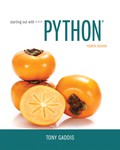
Concept explainers
Future Value
Suppose you have a certain amount of money in a savings account that earns compound monthly interest, and you want to calculate the amount that you will have after a specific number of months. The formula is as follows:
The terms in the formula are:
▪ F is the future value of the account after the specified time period.
▪ P is the present value of the account.
▪ i is the monthly interest rate.
▪ t is the number of months.
Write a
Learn your wayIncludes step-by-step video

Chapter 5 Solutions
EBK STARTING OUT WITH PYTHON
Additional Engineering Textbook Solutions
Database Concepts (8th Edition)
Introduction To Programming Using Visual Basic (11th Edition)
Electric Circuits. (11th Edition)
Computer Science: An Overview (13th Edition) (What's New in Computer Science)
SURVEY OF OPERATING SYSTEMS
Starting Out with Java: From Control Structures through Objects (7th Edition) (What's New in Computer Science)
- Q.2. Architecture performance [25 marks] Consider two different implementations, M1 and M2, of the same instruction set. M1 has a clock rate of 2 GHz and M2 has a clock rate of 3.3 GHz. There are two classes of instructions with the following CPIs: Class A CPI for M1 CPI for M2 2.f 1.g B 5 3 C 6 4 Note that the dots in 2 fand 1.g indicate decimal points and not multiplication. a) What are the peak MIPS performances for both machines? b) Which implementation is faster, if half the instructions executed in a certain program are from class A, while the rest are divided equally among classes B and C. c) What speedup factor for the execution of class-A instructions would lead to 20% overall speedup? d) What is the maximum possible speedup that can be achieved by only improving the execution of class-A instructions? Explain why. e) What is the clock rate required for microprocessor M1 to be a "1000 MIPS" (not peak MIPS) processor?arrow_forwardPLEASE SOLVE STEP BY STEP WITHOUT ARTIFICIAL INTELLIGENCE OR CHATGPT I don't understand why you use chatgpt, if I wanted to I would do it myself, I need to learn from you, not from being a d amn robot. SOLVE STEP BY STEP I WANT THE DIAGRAM PERFECTLY IN SIMULINKarrow_forwardI need to develop and run a program that prompts the user to enter a positive integer n, and then calculate the value of n factorial n! = multiplication of all integers between 1 and n, and print the value n! on the screen. This is for C*.arrow_forward
- I need to develop and run a C* program to sum up integers from 1 to 100, and print out the sum value on the screen. Can someone help please?arrow_forwardGiven the schema below for the widgetshop, provide a schema diagram. Schema name Attributes Widget-schema Customer-schema (stocknum, manufacturer, description, weight, price, inventory) (custnum, name, address) Purchased-schema (custnum, stocknum, pdate) Requestedby-schema (stocknum, custnum) Newitem-schema (stocknum, manufacturer, description) Employee-schema (ssn, name, address, salary) You can remove the Newitem-schema (red).arrow_forwardTrue or False: Given the sets F and G with F being an element of G, is it always ture that P(F) is an element of P(G)? (P(F) and P(G) mean power sets). Why?arrow_forward
- Can you please simplify (the domain is not empty) ∃xF (x) → ¬∃x(F (x) ∨ ¬G(x)). Foarrow_forwardHistogramUse par(mfrow=c(2,2)) and output 4 plots with different argument settings.arrow_forward(use R language)Scatter plot(a). Run the R code example, and look at the help file for plot() function. Try different values for arguments:type, pch, lty, lwd, col(b). Use par(mfrow=c(3,2)) and output 6 plots with different argument settings.arrow_forward
- 1. Draw flow charts for each of the following;a) A system that reads three numbers and prints the value of the largest number.b) A system reads an employee name (NAME), overtime hours worked (OVERTIME), hours absent(ABSENT) and determines the bonus payment (PAYMENT).arrow_forwardScenario You work for a small company that exports artisan chocolate. Although you measure your products in kilograms, you often get orders in both pounds and ounces. You have decided that rather than have to look up conversions all the time, you could use Python code to take inputs to make conversions between the different units of measurement. You will write three blocks of code. The first will convert kilograms to pounds and ounces. The second will convert pounds to kilograms and ounces. The third will convert ounces to kilograms and pounds. The conversions are as follows: 1 kilogram = 35.274 ounces 1 kilogram = 2.20462 pounds 1 pound = 0.453592 kilograms 1 pound = 16 ounces 1 ounce = 0.0283 kilograms 1 ounce = 0.0625 pounds For the purposes of this activity the template for a function has been provided. You have not yet covered functions in the course, but they are a way of reusing code. Like a Python script, a function can have zero or more parameters. In the code window you…arrow_forwardmake a screen capture showing the StegExpose resultsarrow_forward
 C++ Programming: From Problem Analysis to Program...Computer ScienceISBN:9781337102087Author:D. S. MalikPublisher:Cengage Learning
C++ Programming: From Problem Analysis to Program...Computer ScienceISBN:9781337102087Author:D. S. MalikPublisher:Cengage Learning C++ for Engineers and ScientistsComputer ScienceISBN:9781133187844Author:Bronson, Gary J.Publisher:Course Technology PtrCOMPREHENSIVE MICROSOFT OFFICE 365 EXCEComputer ScienceISBN:9780357392676Author:FREUND, StevenPublisher:CENGAGE L
C++ for Engineers and ScientistsComputer ScienceISBN:9781133187844Author:Bronson, Gary J.Publisher:Course Technology PtrCOMPREHENSIVE MICROSOFT OFFICE 365 EXCEComputer ScienceISBN:9780357392676Author:FREUND, StevenPublisher:CENGAGE L- Programming Logic & Design ComprehensiveComputer ScienceISBN:9781337669405Author:FARRELLPublisher:Cengage
 Programming with Microsoft Visual Basic 2017Computer ScienceISBN:9781337102124Author:Diane ZakPublisher:Cengage Learning
Programming with Microsoft Visual Basic 2017Computer ScienceISBN:9781337102124Author:Diane ZakPublisher:Cengage Learning EBK JAVA PROGRAMMINGComputer ScienceISBN:9781337671385Author:FARRELLPublisher:CENGAGE LEARNING - CONSIGNMENT
EBK JAVA PROGRAMMINGComputer ScienceISBN:9781337671385Author:FARRELLPublisher:CENGAGE LEARNING - CONSIGNMENT





